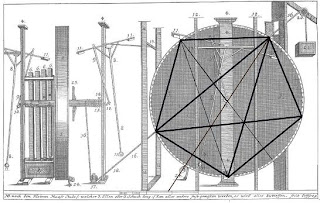It seems clear to me that Bessler's wheel was in a state of continuous imbalance. The first wheels which only turned one way, had to be tied down or locked to prevent them turning. Witnesses reported that the wheel began to turn spontaneously as soon as the lock was released. Bessler said that his "weights are themselves the PM device, the ‘essential constituent parts’, which must of necessity continue to exercise their motive force indefinitely – so long as theykeep away from the centre of gravity."
It has been suggested elsewhere that perhaps the wheel was tied down at a certain point so that it would begin to turn of its own accord when released. I think that if you have a wheel which must be continuously out of balance, which is what I believe a gravity-driven wheel would be, then there would be no need to tie it down at a special place; every position of the wheel would be out of balance.
Bessler wrote textual clues in two ways; he said exactly what the clues suggest he meant, as in the above quotation - or he wrote in ambiguous terms so as not to give too much away; but he did not lie. The sincerity in his words shines through, he was excited about his discovery and, just as we do, he liked to tease us with bits of information. So when he said "weights are themselves the PM device, the ‘essential constituent parts which must of necessity continue to exercise their motive force indefinitely – so long as theykeep away from the centre of gravity," that is what he meant. You can try to read between the lines and get at some other hidden meaning, but there isn't one; it does what it says it does.
I'm well aware of the facts constantly repeated for my benefit, that gravity is not a source of energy. Fine! You believe that if you want to. Bessler's machine worked; he stated that the weights themselves were the PM device; that means that they needed gravity to work, because weights are inseparable from the effects of gravity. Now you may say that gravity cannot provide a force, but falling weights can and do. So the force comes from the weights which respond to the effects of gravity. A simple weight-driven clock gets its energy from falling weights - if that is not tapping the force of gravity then I don't know what is. The solution to the apparent problem of returning the weight to its starting point has been described by me in outline elsewhere and I have also solved the problem of leverage issues - which I haven't described elsewhere.
I know there will be a torrent of attempts to correct my misguided beliefs, but I shall continue on my way content in the knowledge that I am right and you are wrong. I mean those of you who persist in believing that what you have been taught about gravity is the whole truth and nothing but the truth, and insist that gravity can't be used to drive the weights which turned Bessler's wheel. :) Scientists (some of them) maintain that gravity is one of the four forces in physics, albeit the weakest one. In physics, a force is any influence that causes an object to undergo a certain change, either concerning its movement, direction, or geometrical construction. Weights fall under the influence of gravity so it must be a force.
There are other arguments which say that it depends on the theory and framework you're using. If you invoke Newton's mechanics in trying to answer why a ball falls down to earth after you throw it upward, then gravity is certainly a force. If, however, you look at the revolution of the earth around the sun in the context of Einstein's general relativity, then it is less of a force and more of the tendency of massive objects to form curves and dents in space-time.
The answer is much simpler than that - all that matters is that gravity acts like a force here on earth, regardless of how it came about.
JC
10a2c5d26e15f6g7h10ik12l3m6n14o14r5s17tu6v5w4y4-3,’.

.jpg)







